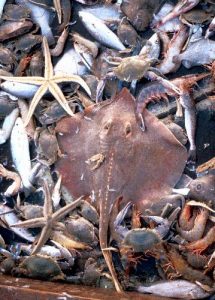Real-Time Spatial Management as a Bycatch Mitigation Measure
By Hannah Calich, RJD Graduate Student
Bycatch, or the unintentional capture of non-target species, has negative biological, economical and social consequences (figure 1). Reducing bycatch has been a fisheries management priority in the US for many years and is increasingly becoming a priority in European fisheries as well. While technical, regulatory and social approaches have all been recognized as ways to reduce bycatch, they are not always effective (Little et al., 2014).

Bycatch from the Gulf of Mexico shrimp trawl fishery. Photo credit: Elliott Norse, Marine Conservation Institute/Marine Photobank
Currently, the primary methods of reducing bycatch involve either creating fishing closures or improving the selectivity of fishing gear. The primary problems with fishing closures are that they can be difficult to enforce and are unresponsive to changes in fish stocks (Little et al., 2014). Increasing the selectivity of fishing gear can create problems when the technology decreases catch of the target species (see figure 2 for an example of a successful gear modification). If the profitability of the fishery is negatively impacted fishers are less inclined to use selective fishing gear (Little et al., 2014). Alternatively, real-time spatial management plans are responsive to changes in stock dynamics and have been proposed as a way for fisheries to reduce their bycatch without impacting the catch of their target species (Little et al., 2014).

Figure 2. A loggerhead sea turtle escapes from a trawl through a turtle exclusion device. Photo credit: http://www.sefsc.noaa.gov/labs/mississippi/images/loggerhead_ted-noaa.jpg
Real-time spatial management plans have been introduced in select European and American fisheries to help encourage vessels to leave areas of high bycatch. Since these plans are relatively new, Little et al., (2014) reviewed ten fisheries across the US and Europe to summarize how real-time spatial management has been successful and where improvements can be made.
While each real-time spatial management plan was tailored for it’s respective fishery, all of the fisheries used their own catch and discard observations to identify areas of high bycatch. Once bycatch levels were identified fishery closures were updated and the news was communicated to the fleet. The time it took fishery closures to be updated varied from hours to weeks depending on the fishery. Real-time spatial management plans benefit fisheries because once areas of high bycatch are identified fishers can avoid them, thus saving time and money. Additionally, there is a positive feedback loop that gives fishers a sense of empowerment and responsibility in managing the natural resources they depend on for their livelihoods (Little et al., 2014).
While real-time spatial management sounds promising, its success depends on the existence of strong leadership and infrastructure (Little et al., 2014). Strong governmental or local leadership is necessary to create and manage fisheries management plans. A strong infrastructure is required to create a real-time communication system that facilitates the collection and monitoring of findings. Additionally, participation, enforcement, and the physical and ecological characteristics of the fishery also influence the success of the plan (Little et al., 2014).
Under the right circumstances real-time spatial management has the potential to greatly assist in mitigating bycatch. However, until the plans are fully developed they should be used in conjunction with other bycatch mitigation measures. Future research is required to determine if using real-time spatial management plans can help mitigate fisheries bycatch over the long term.
Reference:
Little, A.S., Needle, C.L., Hilborn, R., Holland, D.S., & Marshall, C.T. (2014). Real-time spatial management approaches to reduce bycatch and discards: experiences from Europe and the United States. Fish and Fisheries. First published online: 18 March 2014. DOI: 10.1111/faf.12080
